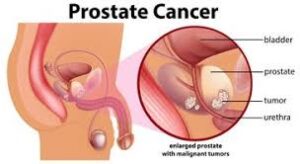Prostate cancer is one of the most common forms of cancer in men. It is estimated that approximately 1 in 8 men will be diagnosed with prostate cancer during their lifetime. In this article, we will explore what prostate cancer is, what causes it, and how it can be diagnosed and treated.
What is prostate cancer?
Prostate cancer is a type of cancer that develops in the prostate gland, which is located below the bladder and in front of the rectum. The prostate gland produces a fluid that helps to nourish and protect sperm. Prostate cancer occurs when cells in the prostate gland begin to grow and multiply uncontrollably, forming a tumor.
What causes prostate cancer?
The exact cause of prostate cancer is not known, but there are several risk factors that have been identified. These include:
Age: Prostate cancer is more common in men over the age of 50.
Family history: Men with a family history of prostate cancer are at increased risk.
Ethnicity: Prostate cancer is more common in African American men and less common in Asian and Hispanic men.
Diet: A diet high in red meat and high-fat dairy products may increase the risk of prostate cancer.
Obesity: Being overweight or obese may increase the risk of prostate cancer.
How is prostate cancer diagnosed?
Prostate cancer can be diagnosed through a variety of tests and procedures, including:
Prostate-specific antigen (PSA) test: This blood test measures the level of PSA in the blood. Elevated PSA levels may indicate the presence of prostate cancer.
Digital rectal exam (DRE): During a DRE, a healthcare provider inserts a lubricated, gloved finger into the rectum to feel the prostate gland for any abnormalities.
Biopsy: A biopsy involves taking a small sample of tissue from the prostate gland and examining it under a microscope for signs of cancer.
If prostate cancer is diagnosed, additional tests may be needed to determine the extent and stage of the cancer.
How is prostate cancer treated?
Treatment options for prostate cancer depend on several factors, including the stage and extent of the cancer, the age and overall health of the patient, and the patient’s personal preferences. Treatment options may include:
Active surveillance: In some cases, prostate cancer may be slow-growing and may not require immediate treatment. Active surveillance involves monitoring the cancer with regular PSA tests, DREs, and biopsies to determine if and when treatment is needed.
Surgery: Surgery may be recommended to remove the prostate gland and any cancerous tissue. Surgery may be performed using traditional open surgery or minimally invasive techniques.
Radiation therapy: Radiation therapy uses high-energy X-rays to kill cancer cells. It may be used as the primary treatment or in combination with surgery.
Hormone therapy: Hormone therapy may be used to block the production of testosterone, which can help slow the growth of prostate cancer.
Chemotherapy: Chemotherapy involves the use of drugs to kill cancer cells. It may be used if the cancer has spread to other parts of the body.
Symptoms of prostate cancer
- Difficulty urinating: Prostate cancer can cause the prostate gland to become enlarged, which can put pressure on the urethra and make it difficult to urinate. Men with prostate cancer may experience a weak or interrupted urine flow, the need to urinate frequently, especially at night, and a sense of urgency when urinating.
- Blood in the urine or semen: Prostate cancer can cause blood to appear in the urine or semen. If you notice blood in your urine or semen, it is important to see a healthcare provider as soon as possible.
- Erectile dysfunction: Prostate cancer can affect the nerves and blood vessels that are involved in achieving and maintaining an erection. Men with prostate cancer may experience difficulty achieving or maintaining an erection.
- Pain: Advanced prostate cancer can cause pain in the lower back, hips, or thighs. The pain may be constant or may come and go.
- Fatigue: Prostate cancer can cause fatigue, which is a feeling of extreme tiredness that does not go away with rest. Fatigue may be caused by the cancer itself or by the side effects of treatment.
Conclusion
Prostate cancer is a common and potentially serious condition that affects men. While the exact cause of prostate cancer is not known, there are several risk factors that have been identified. Early detection and treatment can greatly improve the chances of survival. Men over the age of 50 are encouraged to discuss prostate cancer screening with their healthcare provider.

